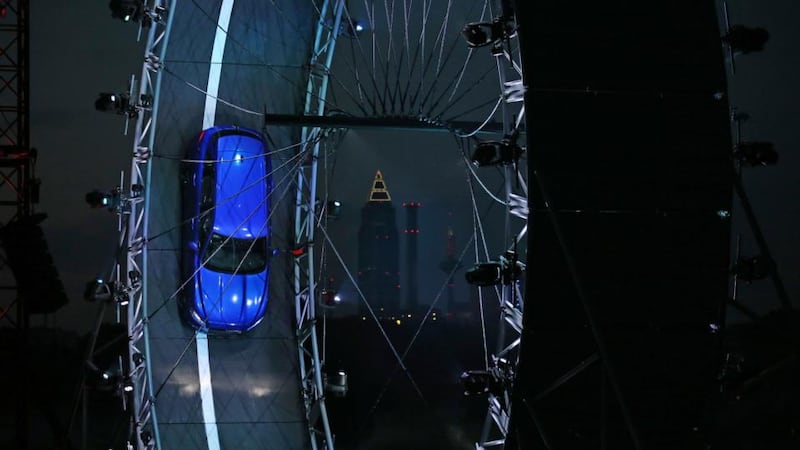Jaguar did a loop-the-loop on Monday night as it marked the launch of its new SUV. One of the new models driven by stunt driver Terry Grant, broke the Guinness World Record for the largest loop the loop drive in a car at a specially constructed event on the eve of the Frankfurt motor show.
Jaguar is synonymous with many types of car, from the sleek and sporty two-seater to the boxy XJs of the 1980s - along with some questionable electronics back then as well.
Things have changed utterly in Jaguar's world, not least with the advent of sleek and stylish saloons like the XF and its new XE, a rival to the BMW 3 Series and Audi A4. Now comes arguably its biggest challenge yet: the Jaguar SUV.

In reality it's not that much of a challenge given that its sister brand is Land Rover, but in terms of brand perception it's a world apart from the British car firm's heritage.
It had little choice, in fairness. SUVs are the fastest-growing passenger car segment on the global market. It's a late arrival in an increasingly crowded space dominated by Audi's Q5 and BMW's X models. The mid-size F-Pace will also face off against competitors from other traditional sports car brands shortly after it goes on sale early next year. Both Maserati and Alfa Romeo are readying their own sport utility offerings.
Jaguar’s new strategy
Arriving in Ireland next April/May, the new SUV is part of a Jaguar strategy to broaden out the brand that began with the XE. Assuming demand for SUVs continues unabated, the F-Pace may become Jaguar's best-selling model, with sales peaking at 44,914 cars in 2017, according to market forecaster IHS Automotive. Though that's a fraction of the Audi Q5's expected sales of 267,784 vehicles, it would move the needle for Jaguar. "One of the things Jaguar has struggled with recently is appealing to a younger audience," said Ian Fletcher, a London- based analyst for IHS. "Because they've focused on sports cars and sedans, it's ruled out a lot of family buyers."
Soaring SUV demand
Demand for SUVs will probably rise 61 per cent by the end of the decade to 19.8 million vehicles, as families continue to choose spacious cars with a sporty edge over station wagons, IHS estimates. “Building a typical station wagon or estate isn’t really going to cut the mustard with consumers,” Fletcher said.
The F- Pace will “fill a hole in the market, despite the fact that a lot of the German brands are the leaders. There are a lot of people who don’t want a German brand, as has been proven by Volvo’s XC90.” Volvo’s new XC90 SUV has exceeded sales expectations, with orders for 65,000 vehicles by the second week of September, compared with a full-year target of 50,000.
Standing Out
In its bid to stand out in the crowded field, Jaguar’s SUV offers extras including a function that compares fuel levels with the length of the planned journey to suggest petrol stations along the way in time. For tricky starts on snow or soggy grass, drivers only need to push a button for the F-Pace to determine how much traction it needs.
Jaguar will probably introduce a plug-in hybrid version of the F-Pace alongside smaller SUV concepts, to rival the BMW X1 and Audi Q3, by 2018.
The big risk is that Jaguar may steal sales from its sister brand Land Rover. Models vulnerable to such a move would be the new Land Rover Discovery Sport and the Range Rover Evoque. However, so long Jaguar executives reckon there is room for all these models in the expanding SUV segment.
The F-Pace is more of a crossover than a full-fledged SUV, featuring a "sportiness" that is "really Jaguar," and doesn't pose a threat of drawing buyers away from Land Rover vehicles, Ralf Speth, head of the Jaguar Land Rover said ahead of the show's opening.
- (additional reporting: Bloomberg)










